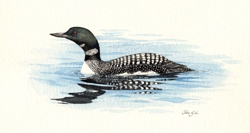Breeding Bird Atlases (BBA)
Find a Bird - BBA1
Breeding Bird Atlas 1 Species Accounts
Common Loon
Gavia immer
State Status
Special Concern
Egg Dates
May 21 to August 16
Number of Broods
one; may re-lay if first attempt fails.

Historically, Common Loons probably nested in suitable locations throughout Massachusetts. However, shooting, loss of undisturbed habitat, and human activities drastically reduced their numbers until, by 1925, Forbush considered them "gone, perhaps never to return" (EHF). Fortunately, northern New England was able to maintain a healthy population of Common Loons, and, when appropriate habitat became available (e.g., the creation of Quabbin Reservoir), they became reestablished as breeding residents by the mid-1970s. Today, a small number of loons also nest in isolated bodies of water in Franklin and Worcester counties. Wintering, and occasionally summering, birds are commonly observed along the coast.
Spring arrival closely follows the melting of ice on the interior lakes and reservoirs used for nesting. These water bodies are generally characterized by having clean, clear water, an abundant food supply, suitable sites for nesting, and freedom from human disturbance. Birds arrive in pairs or pair up shortly after arrival, establish territories of 100 to 200 acres, and begin nest site selection. Nest sites and territories used in previous years are often reoccupied. It is believed that Common Loons pair for life.
Crude nests, often simply shallow scrapes surrounded by sparse vegetative matter, are constructed close to the water’s edge, usually on small islands or promontories. These are often protected from wave and wind action, and their location allows for quick access to deep water.
Common Loon vocalizations fall into four basic types: the tremolo, or loon laughter, generally conveys excitement, alarm, or annoyance; the wail, a three-note forlorn-sounding call, is used to make contact with a mate or young; the yodel, given only by males, appears to be associated with territorial defense or other aggressive behavior; and a variety of hoots and mews are used for communication among members of a family or flock.
Following nest construction, one to three (usually two) eggs are laid, and both adults incubate for 28 to 29 days. Nesting birds may flush from the nest or crouch in position when approached or disturbed. Young loons are precocial and generally leave the nest within 24 hours of hatching. Chicks accompany their parents to a nursery area, usually a sheltered bay or cove with adequate food, which is used for approximately two weeks after the eggs hatch. Chicks are dependent on adults for food and protection for at least two months and are fully fledged at ten to twelve weeks of age. Massachusetts records of adults with small young range from June 22 to August 17 (TC).
Unsuccessful nesters generally leave their territories by midsummer and may join with other nonbreeders at that time. By late summer and early fall, successful breeders also join these expanding flocks at pre-migration staging areas, usually on large inland water bodies. By late fall, migration has begun, although juveniles may remain on their natal lakes until just before the water freezes. Common Loons winter along the Atlantic Coast, from the Gulf of Maine to the Gulf of Mexico, feeding and resting singly or in loose flocks. Young loons may remain on the ocean for several years before returning to inland water bodies to nest.
The Common Loon is listed as a species of special concern in Massachusetts.
Map Legend and Data Summary
Atlas 1 data collected from 1975-1979


Note: rare and local; at Quabbin Reservoir since 1975 and Wachusett Reservoir since 1984, increasing slowly
Paul J. Lyons



